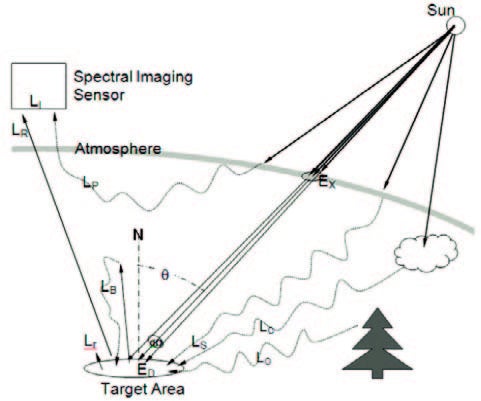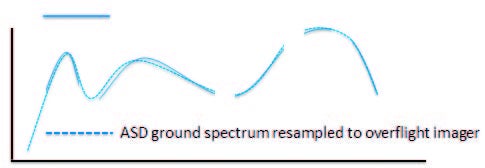“Radiometric calibration refers to a set of techniques that are applied during remote sensing data processing and includes corrections related to the sensitivity of the remote sensor, topography and sun angle, and atmospheric scattering and absorption.” (“Radiometric Calibration”, 2016) “Vicarious calibration refers to any approach that does not rely on an onboard calibrator.” (Thome, 2002)

Figure 1. Considerations for spectral imaging sensor calibration to reflectance and correcting for atmospheric effects. (ASD Inc., n.d.)

Figure 2. Compare ground endmember spectra to overflight spectra. (ASD Inc., n.d.).
ASD field portable spectroradiometers have optimal signal-to-noise design for faster measurements, and wide spectral coverage of 350-2500 nm that is ideal for the vicarious radiometric calibration of a wide range of aircraft and satellite remote sensing systems.
Used in conjunction with 8 to 10° field-of-view fore optics and a calibrated Spectralon panel, our ASD FieldSpec 4 spectroradiometer enables rapid collection of the grid of surface reflectance spectra necessary to characterized calibration targets used for vicarious radiometric calibration of imaging sensors. ASD’s direct irradiance receptor coupled to a solar tracking stage turns the ASD FieldSpec 4 spectroradiometer into a hyperspectral sun photometer enabling the calculation of the atmospheric scattering parameters necessary for accurate vicarious calibrations.
We offer different instrument configurations and additional accessory options for a variety of set-up and sampling approaches for a versatile, wide range of measurement scenarios.
ASD instruments offer a practical solution to analyze vicarious radiometric calibration data measurements. The FieldSpec 4 full-range spectroradiometers are designed specifically around the challenges researchers face when performing spectral measurements in the field.
Ideal for vicarious radiometric calibration applications
Biggar, S. F., Thome, K. J., & Wisniewski, W. (2003). Vicarious radiometric calibration of EO-1 sensors by reference to high-reflectance ground targets. Geoscience and Remote Sensing, IEEE Transactions on, 41(6), 1174-1179.
Clark, R.N., Swayze, G.A., Livo, K.E., Kokaly, R.F., King, T.V.V., Dalton, J.B., Vance, J.S., Rockwell, B.W., Hoefen, T., and McDougal, R.R. (2002). “Surface Reflectance Calibration of Terrestrial Imaging Spectroscopy Data: a Tutorial Using AVIRIS”, 10th Airborne Earth Science Workshop Proceedings. (http://speclab.cr.usgs.gov/PAPERS.calibration.tutorial/)
Czapla-Myers, J. S., Thome, K. J., Cocilovo, B. R., McCorkel, J. T., & Buchanan, J. H. (2008, August). Temporal, spectral, and spatial study of the automated vicarious calibration test site at Railroad Valley, Nevada.
In Optical Engineering+ Applications (pp. 70810I-70810I). International Society for Optics and Photonics.
Leigh, L.; Aaron, D. (2013), Absolute radiometric vicarious calibration of onorbit imaging satellites. Retrieved from http://a-a-r-s.org/acrs/index.php/acrs/acrs-overview/proceedings-1?view=publication&task=show&id=1163.
Minnis, P., Nguyen, L., Doelling, D., Young, D., Miller, W. Kratz, D. (2002), Rapid Calibration of Operational and Research Meteorological Satellite Imagers. Part I: Evaluation of Research Satellite Visible Channels as References, Journal of Atmospheric and Oceanic Technology(19), 1233-1249.
Radiometric Calibration. (n.d.). In Wikipedia. Retrieved March 11, 2016, from https://en.wikipedia.org/wiki/Radiometric_calibration.
Smith, J.R. (2002), “Radiometric Ground Truthing for Airborne and Satellite Sensor Tests”, Pecora 15/Land Satellite Information IV/ISPRS Commission I/FIEOS 2002 Conference Proceedings. (http://www.isprs.org/proceedings/XXXIV/part1/paper/00078.pdf)
Thome, K.J. (2002), Ground looking radiometric calibration approaches for remote sensing imagers in the solar reflective, in Proceedings of the Pecora 15/Land Satellite Information IV/ISPRS Commission I/FIEOS 2002 Conference, 10-14 November 2002, Denver, Colorado.
Ustin, S.L., & Santos, M.J. (2010, February). Spectral identification of native and non-native plant species. Paper presented at ASD and IEEE GRS Proceedings; Art, Science and Applications of Reflectance Spectroscopy Symposium, Boulder, CO, USA (pp. 1-17).